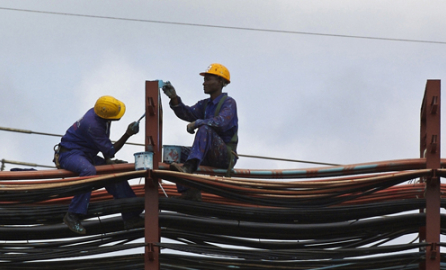The financing needs of the SDGs range up to $7 trillion a year – well beyond the reach of traditional development assistance. Donors are looking at ways to leverage their resources by attracting private financing, for example through blending: combining public grants with loans or equity. Is it working, and how can it be done better? Capacity4dev hears from the authors of a recent evaluation of EU blending from 2007-15.
|
What is blending? The concept isn’t new – the World Bank has been ‘blending’ in one form or another since the 1940s. The principle is to use grants to attract additional financing - loans or equity from public or private financiers. EU blending is organised through seven geographic investment facilities covering Africa, the Caribbean, Pacific, Latin America, Asia and Central Asia, as well as several thematic initiatives. The investment facilities are managed by the Directorate-General for International Cooperation and Development (DG DEVCO). The blending can take the form of grants, technical assistance, risk capital or guarantees. Under the Directorate-General for Neighbourhood and Enlargement Negotiations (DG NEAR), the European Commission also implements blending operations in EU partner countries covered by the European Neighbourhood Policy and in some countries in the Western Balkans region. |
Where it works best
Blending is not well-suited to address all development needs, but it can be catalytic in certain areas, according to a recent evaluation of EU projects. The independent assessment looked at 46 EU projects out of a portfolio of 200 during the period 2007-15. “We found very few cases where they were not working,” said Eric Buhl Nielsen, who led the evaluation team.
Blending accounted for about 4% of the EU’s development budget between 2007 and 2014 – over €2 billion. “Blending enables the EU to reach further,” said Buhl Nielsen. “It isn’t for helping the poorest of the poor on welfare issues – there are other instruments for that. One needs to bear in mind where it is that blending has a comparative advantage.”
The first key area is infrastructure sectors such as energy, transport, water and sanitation. Rather than attempting to develop these capital-intensive sectors with grants alone, “It makes sense for projects which have a revenue stream, particularly electricity and water, but even roads with tolls and petrol taxes, to let them pay for themselves,” said Buhl Nielsen.
The necessary loans are mobilized with EU support through blending, which is formulated on a case by case basis – for example funding the feasibility study or environmental impact assessment; or taking on the riskiest tranche of the debt, enabling other investors to come in.
The key is additionality – ensuring that EU funds bring about development gains that wouldn’t have come about through the private sector alone.
A good example to learn from was a project in Benin, where an electricity transmission line was to be built to the port city Cotonou. It wasn’t feasible for the electricity supplier or the banks involved to connect the 81 small villages on the way, due to their low power consumption and the maintenance difficulties of long stretches of line. Here, an EU grant through the EU-Africa Infrastructure Trust Fund made it viable to connect the rural communities in Atlantique Province; and a further grant went into improving electricity access in Cotonou’s suburbs.
“That was a particularly interesting case of where blending can bring social benefits to an overall investment project,” said Vincent Coppens, project director for the evaluation. “Electricity is very important to create jobs, to develop the entire area economically, so overall in terms of indirect poverty reduction it is important. But with blending it could go further, in particular to add 81 villages to the project, and have a direct benefit for the poorest people.”
The second key area blending opens up is supporting countries in transition to middle income or lower-middle income status. Around 30 countries made the transition up from lower-income status between 2000 and 2014 – a positive sign, though it brings certain vulnerabilities, for example losing eligibility for development grants.
“It’s not possible for those countries to take on new loans unless there is blending - unless there is a grant associated,” said Buhl Nielsen.
Around half the evaluated projects were in countries which are part of the IMF Debt Sustainability Framework – an agreement indebted countries make with the IMF not to take on new loans unless they are highly concessional, usually to the tune of 35%.
“Blending allows countries that don’t have the fiscal space to go ahead with a project - even if that project might make economic sense in all different ways - to do so,” said Buhl Nielsen. “Instead of waiting five, ten, fifteen years or longer, blending accelerates some of the positive economic developments that could come from these projects.”
Watch the following video for Eric Buhl Nielsen (team leader), Vincent Coppens (project director) and Ritha Sukadi Mata (evaluation expert) on the scope of the evaluation (0:05); where blending can add the most value (0:50); examples of blending projects in action; and DEVCO’s Roberto Ridolfi on the key takeaways (3:22) and the future of EU blending (4:10).
How it can work better
The evaluation found that the majority of EU blending projects were working well, but that there was scope for improvement in several areas. “For example in some cases there was an opportunity to enhance the poverty alleviation, or the development impact of those projects,” said Buhl Nielsen.
This comes with an acknowledgement that “it’s a challenge for any development project to be able to provide concrete figures for the final impact of the project, to prove it works or not,” said Ritha Sukadi Mata, contributor to the report. “If you build a bridge, people can access the main cities, find jobs, and it improves their situation – we assume. We cannot really measure or check.”
“You must remember that these are very complex projects in challenging conditions,” said Buhl Nielsen. He recommended that projects integrate indicators for poverty alleviation in their results matrices - “Otherwise it only happens by accident.”
Another key recommendation concerns the transaction costs that partners still encounter with co-financing. According to Buhl Nielsen, the situation is much improved compared to the days of parallel financing (“where one bank would for instance finance the pipes, another one the water treatment systems, and another one the taps, and it would never come at the same time.”). But partners still complain of administrative costs relating to compliance with the different requirements of each partner financial institution, and several rounds of reporting.
The Mutual Reliance Initiative, which gives the lead financial institution responsibility for most project tasks, has been “a quantum leap in coordination”, said Buhl Nielsen. But there is still some way to go, and the authors recommended making sure that all the loans end at the same time. “Otherwise even the project manager might not know when the project ends – is it when the KfW loan ends, or the AFD loan, or the EIB one?” [Germany’s KfW Development Bank, the French Agency for Development (AfD) and the European Investment Bank.]
The evaluation also suggested that the EU use blending to improve access to finance for micro, small and medium enterprises in developing countries.
“For micro entrepreneurs we know that most of the time microfinance institutions are better placed than traditional banks to provide them with financial services,” said Sukadi Mata. “But the thing is that either microfinance institutions are too small or more or less informal, so they can appear to be risky or not the best potential partners for a donor.”
She recommended assessing options beyond lending via the traditional European family of banks (the three mentioned above, plus the European Bank for Reconstruction and Development).
There is already some evidence of this working. “I visited a project in Moldova providing credit to small scale and micro entrepreneurs in rural areas,” said Sukadi Mata. “I met a family in Chișinău running a farm business with pigs and sheep. They said that thanks to the microcredit they received from a microfinance institution involved in the blending project funded by EU, they improved their revenues and they were able to send their kids to school. And they had made improvements to their home, compared to others in the neighbourhood, which was a really concrete example, coming from a big strategy, of the impact for the end beneficiaries.”
According to Buhl Nielsen, many of the concerns that arose in the early days of blending have now been taken into consideration in the new blending guidelines. “So for instance projects nowadays have to look at whether they are crowding in private finance, or perhaps by providing the subsidy they’re crowding it out; they consider the value and size of the grant, and what will be the impact environmentally, and also the impact on jobs. These are all things that have been put much more explicitly into the blending guidelines,” said Buhl Nielsen. “So my short answer would be: follow them.”
To read the rest of the recommendations, see the full report.
Next steps
Roberto Ridolfi, director of Planet and Prosperity at DEVCO, welcomed the evaluation. “We know very well what are the things that we want to improve; and this evaluation coming from an independent source, saying that blending is successful, creating a lot of jobs, a lot of spin and investments, that we must do more of it and we must do it better, it’s indeed the message we wanted to boost our energy and operations in this very important way.”
DEVCO is now preparing a plan of action to share with EU Delegations, which Ridolfi sees as playing an important role in involving EU Member States and other institutions on the ground. “The European External Investment Plan makes a bridge between blending, technical assistance and strategic policy and political dialogue, and that is essential,” said Ridolfi. “Nobody can do that like the EU, not the big banks, not other institutions. We are in a very important position to do this.”
The current economic backdrop could help encourage investors to look towards development financing. “At the moment there is $8.3 trillion sitting on negative interest rates. We want to mobilize that money, and to mobilize you have to de-risk,” said Ridolfi.
“Just think, in the past years we have used €3.4 billion of grants to leverage €57 billion of investments. We want to look in the next financial framework for more blending, more linked to policies.”
Image credit: Jonathan Ernst/World Bank via Creative Commons license 2.0






Log in with your EU Login account to post or comment on the platform.